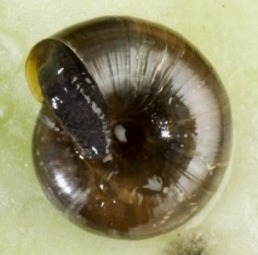
Reproduction
The different ways that Z. nitidus can reproduce is really quite interesting. Z. nitidus is a hermaphroditic species, meaning that they have both male and female sex organs. Pulmonates, like Z. nitidus, are outcrossing hermaphrodites and are also capable of asexual reproduction. This type of species is phally polymorphic, which means that some have a complete functional penis (euphally), others lack a penis (aphally), or have a reduced, nonfunctional penis (hemiphally) (Watson, 1934). Genetic and environmental factors may play a role in the type of phally Z. nitidus expresses. The development of male organs in Z. nitidus can also be influenced by temperature and light (Jordaens et al., 1998).
 One
way Z. nitidus can mate is through the exchange of
spermatophores, which are only formed just before or during
copulation (Jordaens et
al., 1998). However, scientists are unsure of how often the
process of sperm exchange occur, as well as under what conditions it
could take place (Jordaens
et al., 2003). Usually, there are only a few potential males
that may mate with a small number of females, this causes a more
closely related offspring in the population. In most Z. nitidus
populations, inbreeding is frequent and high. Inbreeds account for
the majority of the Z. nitidus population and could go on
for decades unless a group decides to relocate
(Jordaens et al., 2003).
Typically however, the proportion of euphallics in the population of
Z. nitidus is usually low
(Watson, 1934). When
Z. nitidus populations have a low proportion of euphallics,
asexual reproduction is the only possible way to reproduce
(Jordaens et al., 2003).
One
way Z. nitidus can mate is through the exchange of
spermatophores, which are only formed just before or during
copulation (Jordaens et
al., 1998). However, scientists are unsure of how often the
process of sperm exchange occur, as well as under what conditions it
could take place (Jordaens
et al., 2003). Usually, there are only a few potential males
that may mate with a small number of females, this causes a more
closely related offspring in the population. In most Z. nitidus
populations, inbreeding is frequent and high. Inbreeds account for
the majority of the Z. nitidus population and could go on
for decades unless a group decides to relocate
(Jordaens et al., 2003).
Typically however, the proportion of euphallics in the population of
Z. nitidus is usually low
(Watson, 1934). When
Z. nitidus populations have a low proportion of euphallics,
asexual reproduction is the only possible way to reproduce
(Jordaens et al., 2003).
The nutrients consumed by
Z. nitidus can also affect its reproduction. The consumption of prey
in June-July is critical for
Z. nitidus to develop and lay its eggs. During the months of
predation, the shell of Z.
nitidus grows in diameter from 3.4-4 mm at the end of May and
increases by 1.6-2 mm, this is vital for the laying of it’s eggs.
Most Z. nitidus eggs are
laid soon after predation, and slowly grow from September to the
next spring (Rondelaud,
2006).